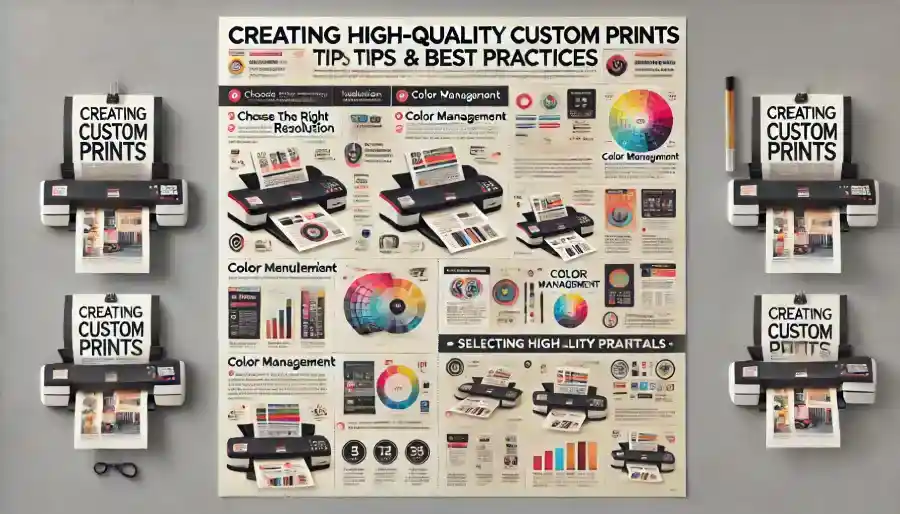Creating High-Quality Custom Prints: Tips and Best Practices
Custom printing has revolutionized how businesses and individuals approach their branding and personal expression needs. By offering tailored solutions for various printing requirements, custom printing allows for unique, high-quality outputs that reflect specific design preferences and brand identities. Custom printing services will enable you to design unique, high-quality products that stand out in any setting, from business cards and promotional materials to personalized presents and clothing. A reputable printing company offers a variety of materials, coatings, and printing procedures that improve the printed items’ appearance and functionality while guaranteeing that every project is completed to exacting standards. Custom printing offers unparalleled accuracy and versatility for both personal and marketing applications.
Understanding the Basics of Design
A well-executed design forms the bedrock of any successful print project, ensuring clarity, engagement, and impact. Everything, from selecting the appropriate color schemes and typography to arranging materials visually pleasingly, adds to the printed piece’s overall efficacy. A thoughtful design attracts attention and communicates the intended message efficiently, guiding the reader’s eye and enhancing comprehension. Whether it’s a brochure, poster, or business card, investing in a robust design can significantly elevate the professionalism and appeal of the final product, ultimately achieving the desired results.
Choosing the Right Materials
The choice of materials significantly influences custom prints’ tactile and visual qualities. Materials like high-quality photo paper and canvas have unique characteristics that affect the final product’s appearance, durability, and purpose. Metal prints offer a modern, vibrant look for contemporary spaces, while traditional matte paper provides a classic, refined touch for subdued environments. Careful selection ensures that custom prints effectively convey the desired message and complement their intended setting.
Importance of Color Accuracy
Ensuring precise color accuracy is paramount in printing, especially when maintaining brand consistency. A brand’s perception and recognition can be affected by even little variations in the colors that make up its identity. Accurate color reproduction ensures that logos, packaging, and marketing materials always appear as intended, reinforcing the brand’s image and message across various mediums. By adhering to strict color standards, companies can create a cohesive and professional appearance that fosters consumer trust and loyalty. Therefore, investing in advanced color management systems and high-quality printing processes is essential for any brand aiming to uphold its visual integrity.
Printing Techniques and Methods
Printing techniques have evolved to cater to diverse needs, each offering unique advantages tailored to specific applications. Offset printing is perfect for books, newspapers, and magazines because of its excellent quality and affordability in significant quantities. Digital printing, on the other hand, excels in short runs and personalized prints due to its quick turnaround and minimal setup. Screen printing stands out for its versatility, allowing printing on textiles and ceramics, making it perfect for custom apparel and promotional items. Flexography is widely used for packaging thanks to its ability to print on flexible materials and produce vibrant colors. Each method has strengths, ensuring businesses and individuals can choose the best fit for their printing needs.
Effective Use of Typography
Typography encompasses more than the mere selection of fonts; it involves the thoughtful arrangement of text to enhance readability and engagement. Text alignment, line spacing, and font size can significantly influence a reader’s eye path and attention span. Effective typography requires an understanding of how different typefaces convey different tones and emotions, influencing the overall impact of the content. By balancing aesthetics and functionality, typography transforms plain text into an inviting and compelling visual experience, ensuring the message is seen, felt, and understood.
Ensuring Quality and Consistency
Ensuring consistent quality control in your print projects is vital for upholding high standards and achieving professional results. Quality control involves meticulous attention to detail at every stage of the printing process, from the initial design to the final production. By implementing rigorous checks and balances, you can catch and correct errors early, ensuring that colors are accurate, text is crisp, and materials meet your specifications. This helps you avoid expensive mistakes and improves your printed products’ overall legitimacy and impact, reflecting well on your business and making a lasting impression on your audience.

